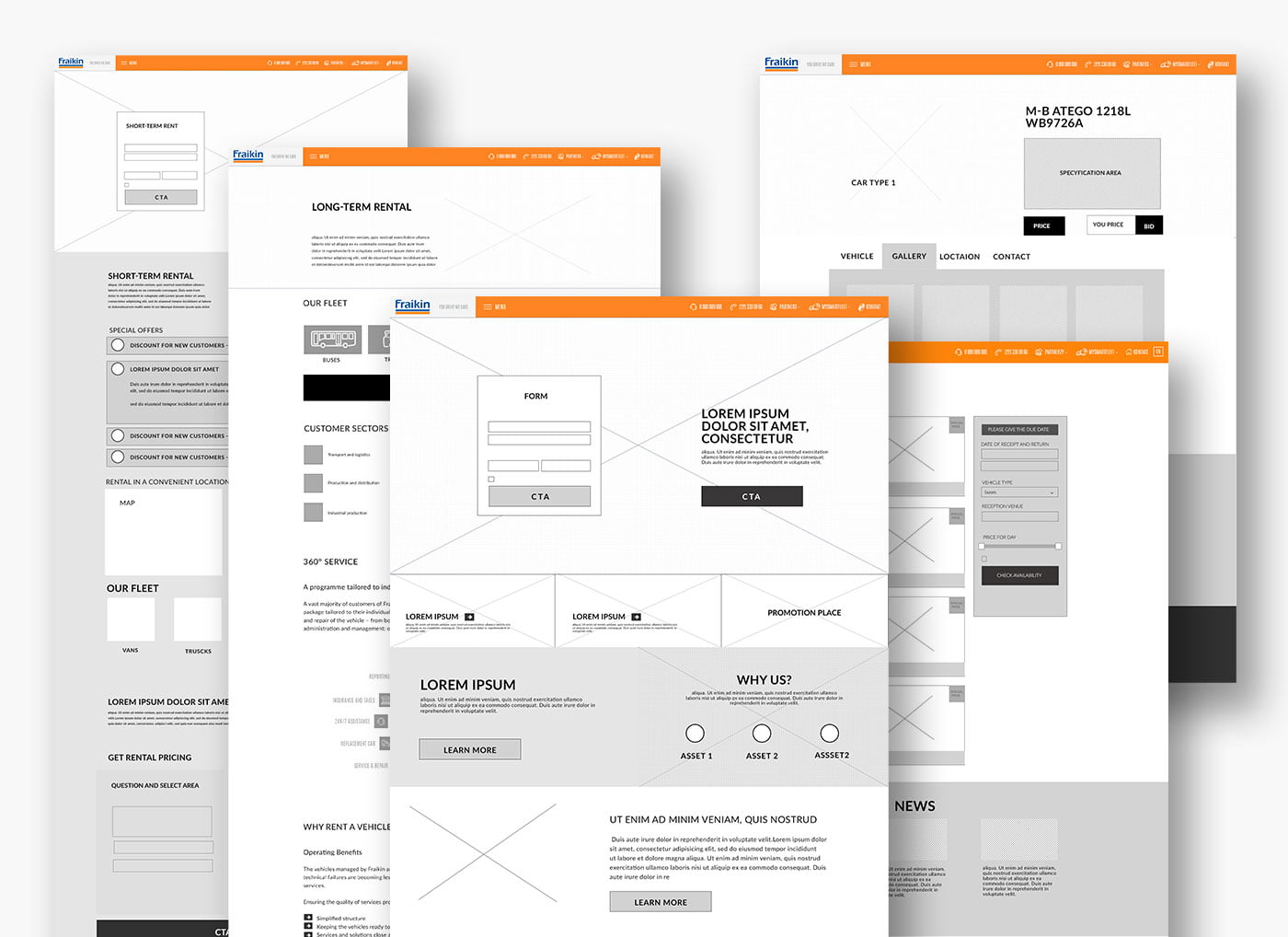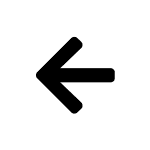Unification of the international Internet service
Fraikin – the road to unification.
Unifying an international website
In this case study you will find out what difficulties you face when redefining and creating a website for an international organisation. What processes take place at each stage of cooperation, what dangers lurk and why communication and flexibility are important. This is a story full of twists and turns, as befits iteration. If you are a company with a similar profile or scope, you will find a lot of valuable information and directions to follow together with the creative agency responsible for your website.
Here we go!
Our client was Fraikin, a company that provides a range of transportation solutions to businesses in various industries. The main branch in the company’s offer is short- and long-term vehicle rental. Our Client has a stable position on the European and global market, and its branches are located in 15 countries.
What the client was missing was a coherent visual communication and offer in the Internet space, lack of a single database and tools allowing to manage many pages in one place. Additionally, the Client wanted to organize the structure and create templates, corresponding to the level of development of a particular branch. Each of the sixteen units (as of 2018) had a different offer, a different fleet of vehicles, and a different scope of service.

Based on conversations, expectations, and plans, the following goals crystallized:
- Establish business objectives for each site type,
- Acquisition of leads,
- Automation,
- Integration of systems,
- Standardization.
For us as an agency, the main goal was to handle an international project comprehensively, and thus to create standards and procedures both within our organization and in contacts with the client. A dedicated team was formed to coordinate tasks, design and implementation.
First, the marketing department of our client, decided to merge the idea of business goals with the standardization of the service. This consisted in analyzing the current services in each of the branches, characterizing them and grouping according to the similarity of characteristics. What we knew from the very beginning was that it is impossible to prepare one website for the whole organization. Based on our thoughts, and with the help of the above-described classification, the idea of creating three versions of the site was created: BASIC, STANDARD and ADVANCED corresponding to different levels of brand development in a given country.
Each of the subtypes was supposed to achieve slightly different goals. For example, Basic was a typically informative site, and the main lead was to be the contact form, as customer service was still in the hands of the branch staff. Advanced, on the other hand, was based on maximum automation – a detailed personalization of the vehicle search engine, combined with an online booking process. The main difference was the scope of the main menu and functionalities including a dedicated page. We managed to standardize the project (only three types of pages instead of fifteen), as well as keep the range of individual features (smaller or more extensive menu).

“Design is not just what it looks and feels like.
Design is how it works.”-Steve Jobs
According to the above maxim, what is most important for the project is its functionality. In order to create a complex and easy-to-use product (in this case, a website), it is necessary to go through a full design process, not taking shortcuts. This requires commitment on the part of both the client and the agency. We combined the SEO audit[1], knowledge from our client’s marketing department with our experience in website development and on this basis we created wireframes of the website. This stage of work allows us to spot errors already on the prototypes, which reduces costs (errors on a later stage of implementation are simply more expensive, sometimes requiring starting a process from scratch). Additionally, wireframes show how the website will work, what the content structure will be and where the various elements will be located. This is the stage to check if our assumptions are correct, which segments can be improved, and which should be removed or added.
[1] SEO – (ang. search engine optimization; also known as positioning) processes aimed at achieving the highest possible position for a given website in the organic results of Internet search engines for selected key words and phrases.
(Source: https://pl.wikipedia.org/wiki/Optymalizacja_dla_wyszukiwarek_internetowych)

“Good design is the silent ambassador of your brand”
Paul Rand
After the prototyping stage came the time for graphic design. Here, however, we focused on evolution, not revolution – the model for all types of services was the website of Fraikin’s Polish branch – the new layouts had to be adjusted to the existing style. It might seem that such an action is easier for a graphic designer, but it imposes many limitations at the very beginning. We had to familiarize ourselves with the grid used so far and base new assumptions on it. We created 28 screens for the Basic version, 29 for the Standard version and 33 screens for the Advanced version. We introduced another stage of standardization consisting in unification – unification of constructional features (common layout for all types of pages, the same grid and colors, type and manner of placing images, etc.).
It should be mentioned at this point that the process of acceptance of the project went through several stages, starting from the evaluation of the main center in France, through individual countries. Because of this, some interesting solutions emerged that could have been considered problems at first. While the main office was in agreement with the presented model (tri-partite service), some countries expressed their concerns about such a far-reaching unification. We leaned into their comments, and the result was the creation of additional subpages for each country. As a result, additional screens were created: 9 screens for Germany, 7 for Spain, 3 for the UK and in addition the French site became a sort of hybrid of the Basic and Standard versions.
In order to leave the client some scope for free editing of subpages, we designed a modular solution from the administration panel, so that the subpages were built section by section and not as a single layout of the entire subpage. Unfortunately, such an approach requires self-discipline on the part of the client and employees to watch over the standardization. What is the risk? When the project contains, for example, six sections on the subpage, and individual countries start to throw out these modules from the template and leave, for example, only two sections (from the beginning and the end of the page), in effect they may look bad.
We always try to make our clients aware that a large website is comparable to a living organism. By putting a larger spectrum of editing in the hands of the client, we are not able to predict all his movements and the resulting errors. Therefore, a good and at the same time safe solution is to entrust the maintenance of the website to IT departments or an agency, which also offers further service.
Coming back to our story, just after we had dealt with the previous challenges, there came another surprise in the form of the brand rebranding! Humming “always look on the bright side of life” we set about redesigning the skin and re-coding some of the pages. These top-down changes contributed to the prolongation of the project duration, as they involved new workload, changes of graphics in accordance with the new CI (corporate identity) and changes on the coding side.

Since the project involved multiple countries, of course implementation followed a predetermined schedule and milestones. After the first publications we could start testing and auditing. The first problems appeared: the speed of the homepage had a high rating on mobile devices (84/100), but not on desktop anymore (45/100). There was a problem with images and cache.
The solutions we applied, among others:
- Compressing images,
- Enabling caching in the browser,
- Minifying javascripts,
- Combining icons in CSS.
But the most important aspect of the implementation was to create a common environment for all countries. This was helped by WordPress Multisite – a system where it is possible to manage multiple sites using a single admin panel. Until now, each branch had a separate server, database and was running different systems – depending on the country. Deciding to put the website in one system, our client, regardless of the location, could use the same templates, plug-ins and finally the same database. Additionally, the Multisite capabilities allowed us to place content tailored to a given country using a single panel. These changes did not affect other locations. Thanks to the integration of the systems into one tool, we met our initial goal. Since the service was a new, unfamiliar environment for the employees responsible for the sites on the client’s side, we prepared video instructions for each country to navigate the administration panel.
The last challenge for us was the issue of security. Already after the loss of the site, the audit indicated almost 300 attacks per day. We performed updates of all systems and security upgrades. We made our client aware of the fact that the security area should be supervised systematically and should react to system updates and any undesirable actions. Such tasks are usually handled by the IT department in a given organization or are outsourced to an external company.
The final result of this journey was a smoothly operating system that meets the needs of our client. We, on the other hand, have gained a lot of experience in the form of knowledge, interpersonal contacts, management methods or the so-called “fire-fighting” 😉 Despite the amount of work and energy put into this over a year-long project, we derive a lot of satisfaction from the accomplished goal.
See you in future projects!



